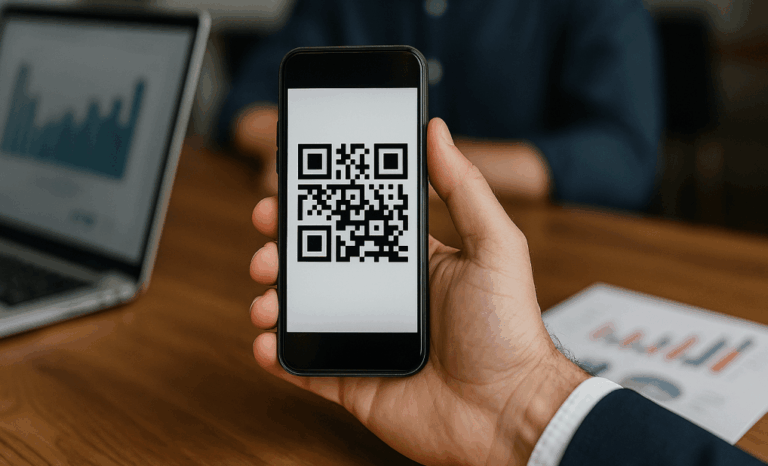Why should we talk about QR code retargeting strategies?
If someone scans your QR code, they’re curious. Interested. Possibly seconds away from buying. But what if they don’t? What if they close the tab, get distracted, or forget?
That’s where actionable strategies related to QR code retargeting come in.
Retargeting helps you reconnect with people who scanned your QR code but didn’t convert, whether that means buying, subscribing, downloading, or whatever your end goal was.
It’s a way to give your offline campaigns a digital memory and your audience a second chance, providing valuable data in the process.
If you’re using dynamic QR codes, you’re already one step ahead. Let’s walk through what works, what doesn’t, and how to make your QR code campaigns retarget-ready.
What does QR code retargeting actually mean?
QR code retargeting means following up with users after they scan a QR code. It often involves tracking that scan and triggering retargeting ads on platforms like Facebook or Google.
However, it can also include tailored emails, personalized landing pages, or unique offers based on that interaction.
The idea is simple: one scan = a new opportunity.
This strategy bridges the gap between offline and online interactions, helping brands stay top-of-mind after that initial curiosity.

Can you really retarget someone just by scanning a QR code?
Yes and no.
The QR code itself doesn’t track people, but the destination URL it points to can.
If you’re using a dynamic QR code generator like QR Code KIT, the platform can log each scan and direct users to a trackable landing page.
You can retarget those visitors later if that page includes tracking tools like Google Tag Manager or Facebook Pixel.
That’s the basic setup. But how do you use that data? That’s where strategy kicks in.
What kind of data can you capture from QR code scans?
A scan alone won’t provide personal details like names or emails.
But you can collect key context, such as when the scan happened, where it came from (in general terms), and what type of device was used. You might also see details like the operating system and browser language.
All of this QR code data helps you understand patterns and behaviors.
Platforms like QR Code KIT make it easier to act on these patterns by offering editable destinations, branded QR codes, and custom domains that keep your QR strategy flexible.
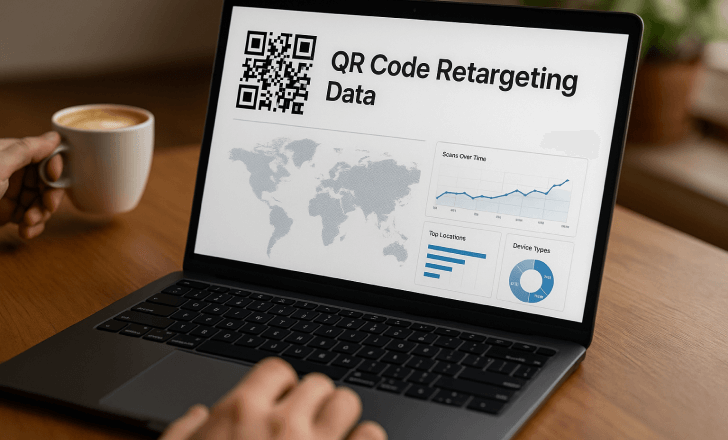
How does QR code data support personalized marketing?
You don’t need to know someone’s name to personalize their experience. With dynamic QR codes, even anonymous scan data can fuel personalized marketing strategies.
Factors like location, time of scan, device type, and engagement history help shape unique user journeys.
For example, an in-store scan might lead to a different landing page than one in a print ad. Someone who scans twice within a week could be shown a time-sensitive offer, while new visitors get a product intro.
This kind of segmentation based on first-party data helps deliver valuable content to the right person at the right moment without invading privacy.
Although the QR code retargeting feature does not rely on names or emails, it still provides a strong foundation for behavior-based personalization.
What tools do you need for QR code retargeting?
A few things need to work together. First, you need a dynamic QR code generator that logs scans and allows you to change URLs as needed.
Then you need a landing page with tracking tools, like Facebook Pixel or a Google Tag Manager container.
Finally, you’ll want to connect these to a retargeting platform, such as Google Ads or Meta Ads Manager.
If you’re working with QR Code KIT, you get dynamic code creation and customizable frames with CTAs that make setup simpler and more effective.
Why does your choice of QR code maker matter?
Not all QR tools are created equal. A good QR code maker gives you more than just a scannable image.
It offers control over analytics, design, and destinations. It lets you create dynamic QR codes, update links in real time, and access first-party scan data that helps improve your targeting.
QR Code KIT is one example; it combines ease of use with powerful features for marketing teams.
Choosing the right maker means you can do more than link to a page, enhancing your offline marketing efforts.
You can actually optimize and evolve your QR code campaigns over time.

How do dynamic QR codes help with retargeting?
Dynamic QR codes are built for retargeting. They allow you to swap out destinations, track scans instantly, gather metrics like location and device, and even run A/B tests without reprinting materials.
For any marketer running QR code campaigns, dynamic is non-negotiable.

What are some real-world retargeting use cases?
Imagine a retail brand placing branded QR codes on packaging. When a customer scans the code, they land on a product page. Some might buy right away. Others might not.
With retargeting in place, those who didn’t purchase could later see an Instagram ad for that exact product.
This tactic works for QR codes placed in print ads, flyers, event materials, retail displays, and trade show booths.
Each of these touchpoints becomes a way to continue the conversation later.
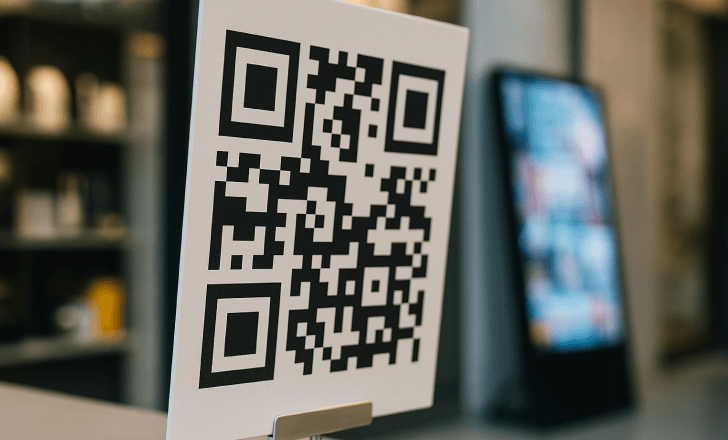
How do you make a QR code retargeting-ready?
Start by creating a dynamic QR code with tracking enabled. Link it to a landing page that contains your pixel or tag manager setup.
Then, use that data to build audience lists within your ad platform. Finally, deliver ads that align with the user’s behavior, guided by detailed insights, whether by timing, location, or device.
Even without tracking pixels, monitoring scans and updating landing pages based on behavior still gives you an edge.
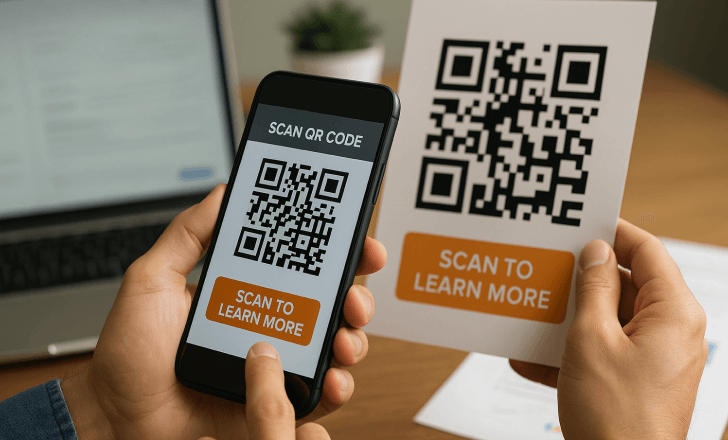
What role does design play in QR code retargeting?
A clean, branded design and a clear call to action make a huge difference. More scans mean more chances to retarget.
Tools like QR Code KIT offer customizable QR codes and attention-grabbing QR frames that come with built-in CTAs, so your code is more than just a square on a page: it’s a real invitation to engage.
Why should you create custom QR codes?
Custom QR codes help your campaign stand out. When the design reflects your brand identity, it increases trust and scan rates. You can adjust the shape, color, or even embed your logo.
This makes the experience feel polished and intentional.
Custom QR codes make tracking campaigns, identifying channels, and running targeted follow-ups easier. Since users often decide in seconds whether to scan, good design can make all the difference.
How do you tell people to scan the QR code?
You should always pair your QR code with a short and specific call to action. Let people know what they’ll get when they scan, whether it’s a discount, more product info, or access to an offer.
Make sure it’s visible and placed smartly, like at eye level or on product packaging.
These small details can dramatically increase scan rates.
What should you consider for QR code placement?
Placement is everything. Whether your QR code appears in print media, on product packaging, or in retail stores, it needs to be where people can easily see and scan it.
Eye-level positioning, good contrast, and logical placement based on context all influence scan rates.
Think about the moment someone interacts with your brand. Are they holding a flyer? Standing in front of a shelf? Walking past a poster?
Each of those offline campaigns becomes more valuable when the QR code is placed with a purpose.
What if you don’t have retargeting tools yet?
You can still do a lot.
Segment your audience by analyzing scan behavior: who scans repeatedly, where they’re located, and when they engage most.
Use this info to customize content, change landing pages, or time your updates better. It’s not the same as full-on retargeting, but it gets you moving in the right direction.
What makes a QR code campaign succeed?
Success comes from more than just getting scans. A great campaign uses dynamic QR codes to guide the user experience, tracks the right data, and delivers relevant content on mobile-friendly pages.
It also includes follow-up touchpoints, like retargeting ads or email flows, and evolves based on what the numbers tell you.
What does QR code data tell you about customer behavior?
Scans are more than clicks; they’re signals. Understanding customer behavior is what turns data into strategy.
You can get a clearer picture of what your audience wants by looking at when and where QR codes are scanned, which devices are used, and how often users return.
For example, if customer scans spike in the evenings, it could influence the timing of retargeting ads or content updates.
If people scan codes in physical stores but don’t convert, maybe your landing page needs better mobile UX, or a faster load time. These small behavioral insights help align your offline and online interactions more closely.
When you treat each scan as a real-world action, QR code data becomes a window into intent.
How do you know if your QR code retargeting is working?
Look at scan volume over time, the click-through rate on your ads, and how often those users convert after being targeted.
Also, track your landing page engagement and whether you see trends tied to location or device. The goal is to keep improving based on user scans and what people actually do.
What can Google Analytics tell you about your campaigns?
Even without complex integrations, Google Analytics can offer key insights into user behavior.
You can monitor essential metrics like bounce rate, average session duration, and conversion paths, all from users who arrived after scanning a QR code.
Linking QR destinations to your GA-enabled pages gives you visibility into how users engage post-scan. This helps you spot friction points and test improvements over time.
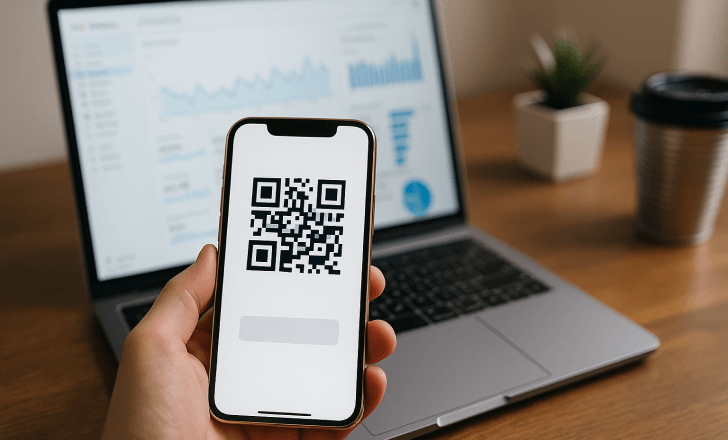
Which key metrics should you monitor?
Scan counts are a starting point, not the finish line. To understand your campaign performance, focus on key metrics like landing page bounce rates, session duration, click-throughs, and time-to-conversion after scanning.
You’ll also want to monitor essential metrics like return scan frequency and geographic engagement clusters. Together, these deliver valuable insights into what’s working and what needs refinement.
The goal is to know how many people scanned and learn what they did afterward and why. This level of detail moves campaigns from decent to high-performing.
How does QR code retargeting fit into your broader marketing campaigns?
Think of QR code retargeting as one layer in your larger marketing strategy. It’s the bridge between your physical assets and your digital content.
When someone scans a code on a flyer or display, that scan becomes the first touchpoint in a multichannel journey.
QR codes support marketing campaigns across formats. They provide intelligent linking, custom landing pages, and social media platforms ready for follow-up.
Whether you’re driving traffic to an online store, seeking to generate leads, or promoting new products, QR codes make your offline and online marketing channels work better together.
How can you drive more user engagement after the scan?
Getting the scan is just the start. Genuine user engagement comes from what happens next.
Your landing page should provide instant access to something valuable, whether that’s exclusive content, a special offer, or a helpful tool.
To increase customer engagement, ensure your digital content is relevant, mobile-optimized, and quickly loaded.
Consider using progressive journeys: a first scan triggers product info, a second unlocks a discount, and a third delivers a loyalty bonus. This encourages deeper online interactions and keeps users returning.
When you use QR codes to build momentum and reach your target audience rather than trigger one-time visits, your campaigns start generating a real connection.
Is QR code retargeting worth it?
Absolutely. If you’re already using QR codes in your marketing, retargeting helps you get more value from each scan.
It keeps the conversation going and improves customer engagement, which in turn helps boost conversion rates and build loyalty.
Where do you go from here?
You don’t need a complex setup to get started.
Start creating dynamic QR codes with QR Code KIT, direct users to trackable landing pages, and monitor key user behavior.
Retargeting gives your QR codes more staying power. It turns a moment of interest from QR code scans into a second chance to connect, and that’s where the real value starts.
